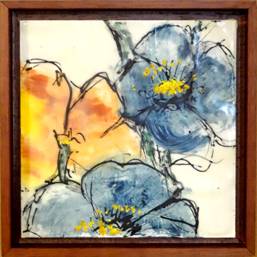 Photo 1
Photo 1
Flower Tile II is about 10 layers of encaustic medium and ink on 8-ply rag mounted to a lifter in a 1" deep walnut stained float frame.
Encaustic is the technique of painting with melted wax colors to a rigid support. The Greek term enkaustikos, meaning "to heat" or "to burn", requires each new layer of melted beeswax medium be hot fused to the previous layer so the wax becomes unified to the support and all previous layers. (photo 1) If each of the layers is not heat fused the painting is not being created in authentic encaustic method and should not be referred to as encaustic, but rather mixed media.
 Photo 1
Photo 1
Flower Tile II is about 10 layers of encaustic medium and ink on 8-ply rag mounted to a lifter in a 1" deep walnut stained float frame.
Brief History
Ancient Greek shipbuilders used beeswax to caulk joints for waterproofing their ship hulls. With the addition of pigments into the melted wax, this hull sealing grew into the decoration of the surface of the hull, as referenced by Homer in 800 BC when writing about the painted warships that sailed into Troy. In 4th century BC, pigmented wax was applied to sculpture, and in Egypt from 100 BC to AD 200 wax portraitures of the dead were set into their mummy casings to help transport their bodies to the afterlife. It continued as a popular medium into the Byzantine era, but fell out of popularity by the 7th century.
There was a slight revival in the late 17th and early 18th centuries, but it remained relatively dormant until Jasper Johns applied it to canvas in 1954, after becoming tired of waiting for his oils to dry. Contemporary encaustics come in all types and styles; are applied to a wide assortment of surfaces; the painting may be smooth or textured; translucent or opaque; all wax; or mixed media—but all are created from fused wax. Encaustic is like no other medium and has truly come into its own.
Medium
Beeswax and dammar resin crystals are melted together to create a basic medium. Once thoroughly blended it is poured through cheesecloth for clarity then into small molds and allowed to harden into blocks. These blocks may later be melted into small loaf pans and mixed with opaque pigment to make colored waxes which are kept liquid during use by sitting the pans on an electric griddle. Bulk medium is melted into a large electric pot for the creation of many layers and embedding materials or brushes for larger artworks. (photo 2)
 Photo 2
Photo 2
Bulk medium—beeswax and dammar crystals—is melted into a large electric pot for the ease of painting on layers and embedding materials. Smaller loaf pans are set on a hotplate behind the pot.
Substrates
Contemporary encaustic medium, opaque, and translucent waxes may be applied to assorted substrates from paper to canvas, all which will impact framing options. Monoprints and surface painted encaustic on paper may become very saturated with wax medium depending on the weight of the paper. (photo 3) Since encaustic does not require glazing these may be easily sink mounted and framed with a laminated mat (mount) and traditional frame. (photo insert 3A) When there is wax saturation starch hinging methods are not possible as the adhesive will not stick to wax. Encaustic medium may be used as an adhesive but will require heat fusion and should be completed by the artist and not the framer since the original will have been modified.
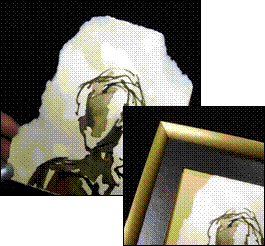 Photo 3 & 3a
Photo 3 & 3a
Medium has saturated the 90# art paper as seen in the two-tone background upper left of the art. The framed encaustic was sink mounted over a color contrasting backing board.
Encaustic medium, opaque wax, and oil stick applies well to 8-ply rag as a substrate, though it soaks additional medium when first applied. An 8-ply board is thin enough to be fitted into a shallow rebate like any ¼" panel and the white surface brightens the painting more than a wood tone panel. (photo 4)
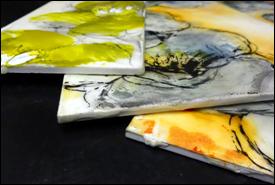 Photo 4
Photo 4
Encaustic medium and opaque wax applies well to 8-ply rag as a substrate. It is thin enough to be fitted into a shallow rebate like a ¼" (6mm) panel.
Honeycomb panels are available as either conservation rag paper or bleached Kraft paper. Tycore and Hexacomb panels boast all the benefits of white or black rag surface paper and the stiffness of a cradled panel box for larger encaustics. Gatorboard available white, black and Kraft, up to 2" thick is also an option. It has a veneer layer, top and bottom, beneath the surface papers making it more rigid. (photo 5)
 Photo 5
Photo 5
Assorted encaustic paintings on (L) Tycore ¾" (19mm) and 8-ply (3mm) rag. Substrates (R) Tycore ¾", ½" (12mm), white ¼" (6mm), white Gatorboard, ¼" birch plywood, ¾" birch plywood. Commercial cradled panels standing in back.
Luan (¼" mahogany plywood), smooth furniture grade Maple or Birch panels, and treated Masonite make up a variety of wood panel options for encaustic. Since encaustic painting has its origin on wood based substrates, neutral pH materials need not be used. Wood panels that are reinforced with ½" thick side strips (up to 3" deep) are known as cradles. These are favored substrates by many encaustic artists—especially large 48x96" paintings—but even with corner and cross bracing these can still warp.
Medium Thickness
By their essence, layered encaustic paintings have more thickness than a painted watercolor or pastel with ¼" to ½" thicknesses of medium being quite common. (photo 6) If thick encaustic is applied to paper alone with no rigid support beneath, the wax may easily be cracked or damaged during handling or transporting so extreme care must be taken when framing. The wax surface is very delicate, even though it has been hardened by resin, and may be easily fingerprinted, scratched or gouged. It should be gently handled like the surface of sensitive acrylic or coated museum glazing.
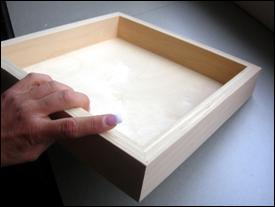 Photo 6
Photo 6
Commercial panels come 1"-3" (25 to 76mm) thick with ½" thick side support strips. Larger panels may have corner and cross bars.
Another favored application is the encaustic pour. The substrate edge is banded and hot medium is poured into it. Manipulation of the panel while the wax sets up allows for interesting variations of the level of the wax surface. (photo 7) Floater frames are favored for these types of presentations.
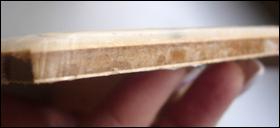 Photo 7
Photo 7
Nearly ¼" of medium has been layered onto ¼" Russian birch plywood panel.
Encaustic Depths and Edging
The surface and edging of any encaustic painting will determine the type of float frame and the distance required for the float space. Paintings on rigid substrates will have any number of finished edges. A cradle or wood panel will often be taped prior to painting to keep the sides clean of wax, or they may be scraped smooth after painting completion. (photo 8)
 Photo 8
Photo 8
Upper left is the corner of a smooth surface heat fused painting. Lower left shows the edge of a ⅜" deep medium pour on a ½" wood panel.
When wax extends beyond the edges of the panel it is called a deckle drip, while a clean scraped edge fits into either a float frame or rebate frame. A raised platform or lifter mount will be required for a drip edge to protect the painting when framed. (photo 9) A framer may not alter an encaustic painting, only the artist may do that.
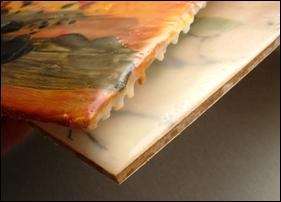 Photo 9
Photo 9
Top left has a natural deckle drip that needs to be lifted from a float frame base with a smaller raised panel beneath. Lower right sample has a clean scraped edge. Neither of these may be altered by the framer.
Float and Recess Spaces
When mounting an encaustic in a float frame, how deep is deep enough? A floater profile must be selected to accommodate the full depth of the art plus substrate, not just the substrate. The depth, setback, or recess from the frame face may be greater for encaustic than for painted oil/acrylic canvases, but in either case it shall always be deep enough to fully protect the surface of the art if the frame were laid face down on a table. Pay attention to all areas of the wax or paint, the setback must be aligned from the highest point on the surface of the art. (photo 10)
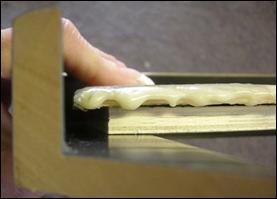 Photo 10
Photo 10
When a deckle drip extends below the bottom of the panel or the panel is too thin to bring it high enough, a platform or lifter should be added.
Traditional stretched canvas recesses are only 1/32" to 1/16", with a float space gap of 1/32" to 1". The spacing for encaustic is not a strict set rule. Encaustic recesses may be anywhere from ⅛" to 1" depending on the size of the art and substrate, with a float space of ¼" to 1" also depending on the size of the panel. Deckle drip edges create uneven sides which will impact float space consistency surrounding the panel. (photo 11)
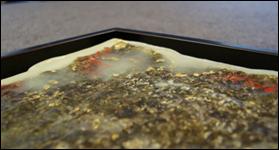 Photo 11
Photo 11
The floater face must be slightly higher than the highest point of the art even with uneven surfaces.
As when designing for mats and mount decoration it is important to avoid repetitious measurements. Variation makes for better proportion control and visual emphasis. If the face of the profile is ¼", the float space should be less than or greater than ¼".
Mounting Options
Unlike an original pastel or oil painting, since encaustic substrates vary, frames and mounting options also vary, including no frame, sandwiched acrylic, float frame, or sink mount. No frame is most common when encaustic is painted on a cradled panel. Large panels are often fitted by the box maker with a French cleat glued inside the back as part of the hanging system. This is the very best hanging system for large, heavy encaustic.
Float frames are favored for wrapped honeycomb, scraped wood panels, and shallow cradled boxes and are available in a wide assortment of profiles and may be stacked. As with gallery wrapped canvases the depth of the wrap or the cradle determines if the art requires a frame or may stand on its own. If a gallery wrap or cradle is less than 1½"—preferable 2"—it may be considered too thin to stand alone. The third alternative for a dimensional encaustic would be a sink mount and cover mat (mount). This would support the substrate with a pinwheel of foam board or 8-ply rag, overlapped ¼" with a window mat and may or may not be glazed.
Final Fusion
Encaustic is a unique medium that has rather specific guidelines when creating, handling and framing. It may be applied to wood or paper, does not require glazing nor does it require preservation treatment making it versatile while still having its own delicate attributes. Artists either love it or hate it and framers need to learn how to handle and respect it. Learn more about the medium from your encaustic artists and they may also learn from you.
END
Copyright © 2016 Chris A Paschke
For more articles on mounting basics look under the mounting section in Articles by Subject.
Additional information on all types of mounting is found in:
The Mounting and Laminating Handbook, Second Edition, 2002,
The Mounting And Laminating Handbook, Third Edition, 2008 and
Creative Mounting, Wrapping, And Laminating, 2000 will teach you everything you need to know about getting the most from your dry mount equipment and materials as an innovative frame designer.
All books are available from Designs Ink Publishing through this website.
Chris A Paschke, CPF GCF
Designs Ink
Designs Ink Publishing
785 Tucker Road, Suite G-183
Tehachapi, CA 93561
P 661-821-2188
chris@designsinkart.com